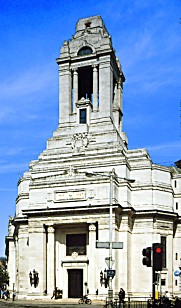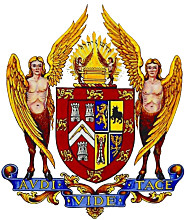|
(1) Some form of 'Acception' within the London Company of Masons, as early as 1620, has been recorded in 'The Records of the Hole Craft'.; (2) Entries in the diary of
Elias Ashmole in 1646 and 1682 talk about the 'Lodge of Elias Ashmole'; he recorded in his diary that a lodge met at his father-in-law�s house in Warrington, Cheshire on 16 October 1646 to make him a Mason. None of those involved was a stonemason; (3) References to a lodge at Chester about 1665 and an entry in the 'Academie of Armoury' by Randle Holme in 1688; (4) There is a short account of masonry towards the
end of the century by the antiquarian, Dr. Robert Plot in his 'Natural History of Staffordshire' , in 1686 and (5) various copies of the Old Charges and Manuscript Constitutions (We will discuss about them in a later
article on this site). Though the existence of masonic activity is thus evidenced, it is not possible to gauge its prevalence.
Organised Freemasonry became established on 24 June 1717 when four London lodges came together at the Goose and Gridiron Ale House, St Paul�s Churchyard,
formed themselves into a Grand Lodge and elected Anthony Sayer, Gentleman, as their Grand Master � the first Grand Lodge in the world.
Initially the Grand Lodge was simply an annual feast for lodges in London but since 1721 it began to establish itself as a regulatory body, attracting
to it lodges meeting outside London. In 1723 the first rulebook � the Constitutions of Masonry � was published and William Cowper, Clerk of the Parliaments, was appointed Secretary to the Grand Lodge to keep minutes of its meetings. By 1730 the
Grand Lodge had over 100 lodges in England and Wales under its control and had begun to spread Freemasonry abroad, warranting lodges to meet in Madrid and Calcutta.
For historical reasons separate Grand Lodges were formed in Ireland (1725) and Scotland (1736). Between them the �home� Grand Lodges took Freemasonry
around the globe. From the 1730s lodges were set up in Europe, the West Indies, North America and India. In the later 18th and the 19th centuries British Freemasonry was taken to the Mid and Far East, Australasia, Africa and South America, by the
colonial rulers of the time. When those areas eventually achieved nation status many of the lodges formed independent local Grand Lodges, but other lodges decided to remain with their parent Grand Lodge � resulting in the United Grand Lodge
of England still having some 750 lodges overseas, mostly in Commonwealth countries.
The premier Grand Lodge of England continued developing in the 1730s and 1740s without any opposition. There had been considerable public interest �
meetings were advertised and reported on in the growing number of local newspapers � more especially in what the ceremonies of Freemasonry were. Enterprising journalists and pamphleteers were not slow to produce �exposures� of what they
believed were the �secrets� of Freemasonry. Publicity increased interest and a growing number of aristocrats, landed gentry and professional men began to seek admission. In 1737 the first Royal Freemason was made - Frederick Lewis, Prince of
Wales, son of King George II.
The United Grand Lodge of England has 804 Lodges operating in a number of countries around the world. Many of these Lodges are overseen by a District Grand
Lodge, of which there are 32. Five groups of Lodges are too small to make up a District and are therefore overseen by a Grand Inspector. Twelve individual Lodges do not come under the jurisdiction of a District or Grand Inspector and are known as NUD
(Not Under District) Lodges.
There is evidence that Freemasonry existed in Ireland 500 years ago. The Grand Lodge of Ireland, is the second oldest Grand Lodge in the World.
Masonry in Scotland claims a much earlier existence. Scottish Freemasonry is now officially recognised as being the oldest in the world and is now recorded as
a Guinness World Record. The Grand Lodge of Scotland (GLOS) Museum and Library contains a most unusual archive with records from 1598. The names of Freemasons from that date are recorded from that time although not in a comprehensive way until 1736
when membership records for all of Scotland's Lodges exist from then to the present day. Aitchison�s Haven, a masonic lodge in Musselburgh, Scotland, has the oldest written records, dating back to January 9, 1599. It ceased to exist in 1856. Mary's
Chapel lodge in Edinburgh is the oldest masonic lodge still in existence.
In the early part of the 18th century there were already 100 independent lodges in Scotland. They were not interested to form themselves into a Grand
Lodge, thus losing the independence. Peculiarly enough , Scottish lodges enjoy a greater amount of freedom compared to other orders.): Scottish masonry is claimed to be the oldest, having recorded minutes of the now extinct lodge rom 1599 - 406
years! For a glimpse of those minutes click on
http://www.grandlodgescotland.com/glos/Literature/Articles/400.html |

 Lodge Minchin has completed 107 years of its existence and today has a matching membership ! History of Masonry in
Kerala is at least 160 years old while masonry in India is almost as old as the movement itself. Before we consider the history of Lodge Minchin, it would be appropriate to know something about masonry in a larger time dimension.
Lodge Minchin has completed 107 years of its existence and today has a matching membership ! History of Masonry in
Kerala is at least 160 years old while masonry in India is almost as old as the movement itself. Before we consider the history of Lodge Minchin, it would be appropriate to know something about masonry in a larger time dimension. 